|
|
review
|
Walking After Midnight: One Woman's Journey Through Murder, Justice and Forgiveness
by Katy Hutchison
Raincoast Books 2006
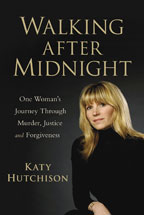 Katy Hutchison didn't want the murder of her husband in their Squamish, B.C. neighbourhood in 1997 to define the lives of her children, four year old twins, Emma and Sam. Instead, Bob McIntosh is remembered in a legacy of forgiveness and restorative justice. Hutchison reached out and Ryan Aldridge, charged with her husband's murder, reached back. Together they are inspiring individuals and communities towards hope and healing. Katy Hutchison didn't want the murder of her husband in their Squamish, B.C. neighbourhood in 1997 to define the lives of her children, four year old twins, Emma and Sam. Instead, Bob McIntosh is remembered in a legacy of forgiveness and restorative justice. Hutchison reached out and Ryan Aldridge, charged with her husband's murder, reached back. Together they are inspiring individuals and communities towards hope and healing.
In a writing style that's plain but true, Hutchison begins her memoir with the events of New Year's Eve, 1997: Bob McIntosh was murdered while trying to break up a teenagers' party at a friend's house. As she moved on with her life following her husband's death, including moving to Victoria, B.C. and falling in love again, Hutchison, as she puts it, suffered and flourished at the same time. As is evident in her book, the new woman Hutchison became has much to do with reciprocity and little to do with retribution.
In 2002, when the police had a suspect in the case, Hutchison recorded a videotape for him which led to Aldridge's confession and arrest. On the videotape, she let Ryan know how hard she had worked along with Emma and Sam to put their lives back together. She said "until the truth comes out there will be no healing". She was referring to herself, him, their families and the community.
The first meeting of the pair, which Aldridge requested in order to deliver letters of apology, is the heart and soul of the book. Hutchison consoled him, saying "the worst is over", and left Aldridge, still sobbing, clutching the photographs of Emma and Sam. The scene brought me to tears as well.
As she forgave herself for letting go of the past, Hutchison created "The Story of Bob" to take into schools, an idea prompted by passing her old Victoria high school one day. It's a story about the lawyer and triathlete and about the potential risks of drinking and drug use.
After engaging in a victim-offender reconciliation process, Hutchison offered Aldridge the opportunity to do school presentations with her. Aldridge's half of the story has to do with taking responsibility and acknowledging the pain suffered by all concerned. He doesn't blame his actions on alcohol but rather on "a need for power and control." Aldridge has since served his jail time and is on parole until December 2007.
As Hutchison tells her story from the time she met Bob McIntosh to her present life, we get to know a brave and resilient woman who is a passionate advocate for restorative justice and continues to learn about peacemaking circles, including those rooted in the medicine wheel of the First Nations. Her story and Aldridge's have also been added to the Forgiveness Project, a British-based non-profit organization.
Hutchison's path was often a lonely one as people couldn't accept the fact she didn't desire vengeance. Her book is a powerful reminder that there is suffering on both sides of the victim-perpetrator fence. She helps us imagine how we can approach forgiveness in our own lives, with hands open
rather than with closed fists. –Mary Ann Mooreback to top Fabric of Faith: A Guide to the Prayer Quilt Ministry
by Kimberly Winston
Morehouse Publishing 2006
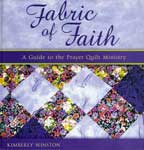
The Ministry, commonly referred to as Prayers and Squares, began in the quilting circle of Hope United Methodist Church in Poway, California fifteen years ago. This particular group of quilters became the founding chapter of what is now a 440-strong network of prayer quilt groups across North America when a member’s grandson became gravely ill and they began making a quilt for him, to comfort and express their support.
In doing so, working silently with fabric and thread, they realized they were all infusing the quilt and their work with prayer. They themselves, as well as others, were quick to recognize the healing and support manifesting through the power of this offering and requests for additional quilts began to arrive.
Fabric of Faith shares the history and evolution of this movement born from their humble beginning. Personal “quilt stories” are interwoven between founding precepts, discussions on working with intention, inspirational quotes, and an extensive how-to section for both making quilts and starting a chapter. Prayer quilters discover something happens – a hidden treasure found – when working selflessly and offering prayer. It seems that healing and love begin to flow through the quilt itself, and both the quilter and the recipient of the quilt receive it.
However, in her attempt to write an inclusive book about this ministry, author Kimberley Winston has become entangled in Christian rhetoric and blinded by her own worldview. She makes worthy efforts to remain open, for example, by outlining the basic tenets of the world’s major religions and making the connection to the universal religious understanding that God is love. Where I find problems with her presentation are the constant reference to God as the Father, the Creator, the One True God as if she is unknowingly “sharing the Gospel” the entire way through. It is confusing and contradictory to read: “When we make and give away a prayer quilt, we affirm that all human beings, no matter what name they call God, are united in their love for him and for each other.”
The wonderful story of this work is somewhat compromised in this quote because God is kept in gender up in a skyward heaven, and mysterious because he is capable of letting bad things happen. Winston is touching on experiences that are real and connective to Divine source, but I am saddened at the need to keep such a controlled and limited understanding on it all.
If you can read with a grain of salt and give thanks for the splattering of other perspectives that Winston offers, Fabric of Faith can be an inspiring and hopeful read. As this ministry continues to grow, perhaps other ways of viewing God, the world and our place within it all will surface and make their way onto the quilting surface, truly allowing everyone space and inclusive room to be. – Sara Torrieback to top Earth Democracy: Justice, Sustainability and Peace
by Vandana Shiva
South End Press 2005
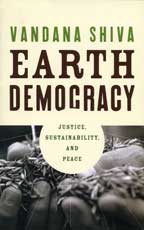
During British rule in India, Gandhi was asked what he thought of Western civilization. He responded, “It would be a good idea.”
Half a century after independence, India lies reluctantly at the feet of a new imperialism. In her latest book Earth Democracy, Vandana Shiva exposes how globalization is putting India, the Earth and its citizens at risk by privatizing natural resources, genetically engineering food and patenting life forms. Using the subcontinent as her model, Shiva illustrates that by enclosing the commons, corporations are displacing citizens from formerly accessible territory, treating the land and its people as disposable commodities and threatening natural resources, ecological sustainability and cultural diversity.
To reclaim culture and civilization, Shiva proposes we take part in what she calls an “Earth Democracy,” a system based on living economies, living democracies and living cultures. Introducing the 10 principles of Earth democracy, Shiva begins her book by quoting Chief Seattle, who in 1848 said, “This we know; the Earth does not belong to man; man belongs to the Earth. This we know. All things are connected like the blood which unites our family. All things are connected.”
Simply put, Earth democracy embraces the awareness of those connections and the rights and responsibilities that flow from them. Shiva encourages societies to cultivate “living economies” that honour nature’s economy and ensure that every being has equal access to the Earth’s resources that make life possible. She supports “living democracies” that resist seeing life as commerce and the world as a commodity. Rather, these democracies prioritize “people and nature above commerce and profits, ecology and equity above trade, citizens above corporations, local democracy above the global market, and people’s lived realities in their everyday life above the abstract constructions of corporate capitalism.” And “living cultures” support the concrete context of culture – the food we eat, the clothes we wear, the languages we speak, and the faiths we hold – as the source of our human identity.
Shiva outlines how we can counteract the agenda of globalization and shows how everyday living cultures are putting Earth democracy into action. Not long ago, 10,000 people in India reclaimed the neem tree, a natural pesticide and medicine used in India for 2000 years, when it was threatened by biopiracy, or corporate patenting of life forms.
In 2004, the Slow Food movement gathered 5000 people from 130 countries to celebrate our Earth mother, “Terra Madre,” and our connections through food and our very humanity. These are just a few examples she gives to show how, by connecting the local to the global through our everyday actions, we can create living cultures based on diversity, alliance and cooperation. “Service, support and solidarity are our means,” Shiva writes.
Vasudhaiva Kutumban means “Earth family” in Sanskrit. In Indian cosmology the human and nonhuman represent a continuum. Patenting life is antithetical to the natural intelligence of the Earth; it’s hostile to the sustainability of that human and nonhuman continuum. Life is not an invention, not a monopoly. Life has its own intelligence. Vandana Shiva calls us to that life we all have a right to, she breathes life back into us and reclaims life for the keepers of biodiversity. – Nancy Millerback to top Pranayama Beyond the Fundamentals: An In-depth Guide to Yogic Breathing (with instructional CD)
by Richard Rosen
Shambhala 2006
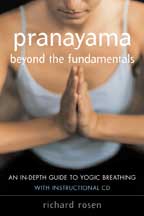
In his second book on pranayama, Richard Rosen expands upon this invaluable yogic technique, which he wrote about in The Yoga of Breath: A Step-by-Step Guide to Pranayama (Shambhala 2002). He takes readers on a deeper journey within themselves through the history, practice and advanced techniques for many different practices of pranayama, as well as bandams and mudras (inner and outer physical locks and seals).
Any aspirant with a consistent practice and understanding of the importance of pranayama will find this book to be a great reference guide when a physical, experienced teacher is not present. Throughout the book Rosen maintains a subtle sense of humour, which encourages a feeling of calm and casualness and ultimately allows the information he imparts to stay with the reader. Absent is the academic exposition often associated with many instructional manuals.
Many of the techniques described within these pages may seem familiar to the experienced practitioner. If approached with an open and empty mind, one may experience an even deeper state of calm and relaxation through the many subtle indications of physical adjustments in each of the techniques. The mere practice of witnessing the mind through the reading and practising of these techniques will allow for a deeper and more rewarding personal practice. There is some focus on asana but only as a complementary practice to his writing and teaching of pranayama.
When detailing the specific practice of a pranayama exercise, Rosen’s directions resemble a typical Ashtanga asana class – there is a demonstration of the asana, an explanation of its benefits, followed by a deeper, more advanced version of the posture. For each pranayama exercise, Rosen gives a background of the practice, an explanation of its benefits, a preparatory exercise, and the actual practice followed by an optional, more advanced modification. By detailing the art and practice of pranayama in this familiar manner, the reader is able to assimilate the connection between the practices and the benefits of inner awareness and growth.
For novices, this book should act as a beacon to deepen their yoga practice. The accompanying CD serves as a nice reference “class” after completing the book, and creates a sense of being with a physical teacher.
The appendices are also a useful adjunct to the book’s contents as they outline a grouping of the many practices to formulate a suitable, personalized pranayama class, as well as some important physical cleansing techniques for maximum benefit. Any aspirant of yoga would do well to take the time to learn from these pages either as a refresher or as a new gateway to self-exploration. – Paul Gangadeenback to top How to Save the World in Your Spare Time
by Elizabeth May
Key Porter Books 2006

Sure, I want to save the world. But who has spare time? We’re busy people these days. Yet I’ll wager there’s many who want to give their time if it isn’t a waste. We want to make a difference, so we need to know how to act effectively.
This is one of Elizabeth May’s contributions with this book. She outlines how to make your time and effort matter when you engage in work to save the world – whether your world is a piece of forest or wetland, or a neighbourhood sitting on a toxic waste dump.
May distills her lifetime of experience in chapters that explain how to get organized and set goals, how to navigate the media so your campaign gets in the news, how to lobby and fundraise, and how to keep perspective.
She’s got a lot of experience to draw from. May’s mother (often with young Elizabeth at her side) initiated a campaign for nuclear disarmament and ended up working with people such as Norman Cousins, Bertrand Russel, Benjamin Spock and Linus Pauling, “as well as hundreds of other average, everyday folk who banded together to change the world.” Elizabeth learned at an early age that ordinary people can make a difference. “My mommy changed the world,” she discovered. “So can I.”
She became an environmental lawyer, worked in government as assistant to the Minister of Environment, became executive director of the Sierra Club of Canada, and just recently head of the federal Green Party. She’s got a commitment that most of us won’t have, maybe don’t want to have. But her book isn’t trying to convert to her level of involvement.
This is one of several aspects that I appreciate about it. She presents ways to make action effective and leaves it at that. I also appreciate that May never hints at a hierarchy of worth based on how much someone takes on (the environmental version of “holier than thou”).
A third aspect I appreciate is that May has kept a perspective in her work. She has not lost sight of humour and the importance of simple pleasures. The world may be in crisis but we can still take joy in its being. She cares deeply about the environment and has met the dark side of industry, profiteering and consumerism, but she has not sacrificed her commitment to nonviolence or her commitment to maintain dignity and respect as she engages in a challenging struggle. She’s faced defeat and not been defeated herself. She’s met success when everything said, “This one’s impossible.” She conveys all this through stories and anecdotes about her history of activism and the people she’s worked with (and against).
Each chapter concludes with a list of key learnings. This means that after you read the book, you can brush up on the significant aspects when the time arrives to apply the wisdom May offers.
So, you don’t need spare time to enjoy this book or to benefit from it. You can learn how to save the world through what May has learned. You can give your time and effort effectively and have a good read as well. – Alanda Greeneback to top
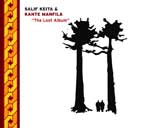
Kante Manfila’s guitar opens this album, painting the horizontal light of a dusty, golden African afternoon. When Salif Keita’s voice joins in, he’s praising the same peaceful scene, his voice raw and velvety at the same time. Manfila’s light fingers pick in tune with alternating xylophone grooves, a tinny horn or clarinet that sounds patched in from the 1950s, and at times, a piano plucking Cuba from across the ocean.
When Keita is not singing, Manfila’s guitar is often the voice, gentle and fluid. He is also percussion, dissolving effortlessly into melody when Keita breathes and the instruments float to the foreground. Keita’s voice sails like an instrument of pure emotive expression, then shifts to storyteller, carrying on histories. The way the musicians play together feels like many circles rippling and receding, conversing. There is ample nuance and subtlety in each song to invite repeat listening.
Salif Keita and Kante Manfila were born within a few years of each other in the late 1940s. Keita is Malian, born into a caste of princes, direct descendant to the founder of the Empire of Mali. Founded between the 11th and 13th centuries, the Keitas organized the Mandingue people with the introduction of Islam, applying a caste system that restricted profession to bloodline. Salif Keita’s inspiration to sing and play music was not supported by his family, as music was the right only of those belonging to the caste of Griots. Born albino, he was rejected by his community because of a general belief that people born with no pigment carried an evil spirit. He left his homeland for the Ivory Coast, and met Manfila playing together in the group Les Ambassadeurs du Motel.
Manfila is a Guinean guitarist, born into the caste of the Griots. Both he and Keita have been influenced by the music from the Mandingue people, blending traditional roots with contemporary explorations. The two have collaborated throughout their respective careers, both prolific with creation since this previously unreleased 1980 recording. At the time, the musical scene on the Ivory Coast was overwhelmingly electric, making this acoustic album an anomaly of its time, a less lucrative choice for record companies.
Recorded 25 years ago, it is interesting to hear the youth in Keita’s voice on The Lost Album – subtle but recognizable after listening to some of his more recent recordings. There is a rawness blending a person and his community to one another. Although it is not explained whether these songs are traditional or contemporary, my ears hear a blend of many different times. The artwork accompanying the disc is beautiful, but there is not a lot of information about who else collaborated with Keita and Manfila. There are numerous instruments, and at times other singers, adding enormous texture and feeling throughout the length of the disc.
I love the sense of curious wonder I feel in this music. Easy conversations become a heart’s passion as I’m washing the dishes. By the end of the album, we’ve sunk like the light of the sun below the horizon into dark reflections and festive celebrations. Ending with a silence like the dawn of morning, a circle feels completed.
– Shannon Grey Duncanback to top
|
|